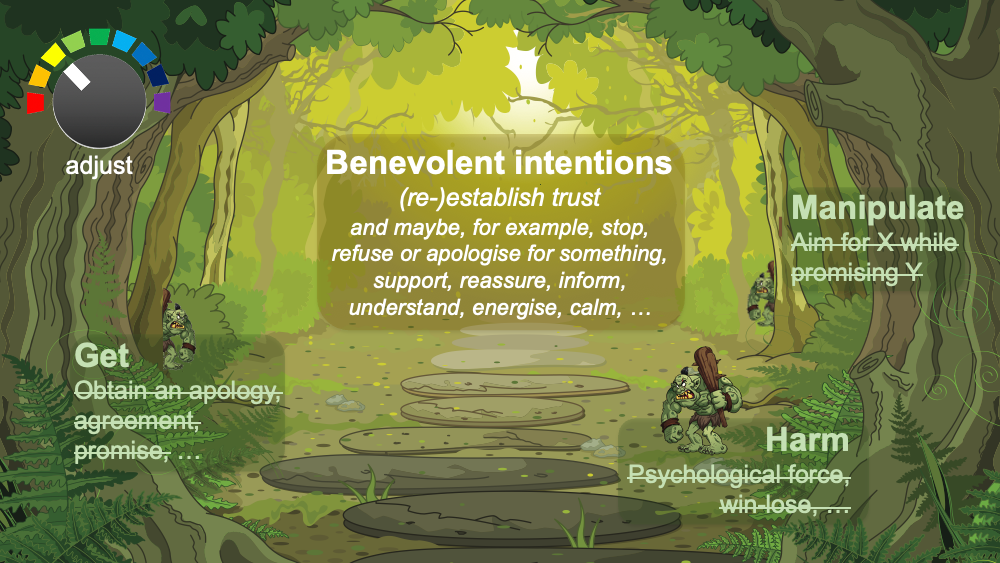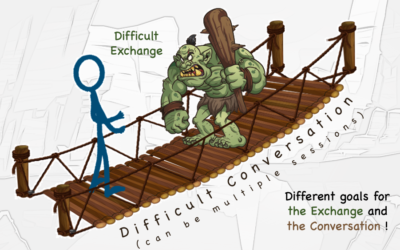My customer brings up supply chain issues again, just as they did last meeting and the one before, and for as long as I can remember now. As usual, this is done just when I’m getting to topics that are important to me and the question is accompanied by an agonized, apocalypse-is-nigh expression.
Having been in this position before, I have relevant data and arguments to hand and my instinctive reaction is be to bring these out, prefixed with an inflammatory, “As I have explained several times already …”.
However, as we’ve discussed in previous articles, a lot of what has been learnt over the years about dealing with Difficult Exchanges is counterintuitive. Habit and instinct cannot be relied upon and so I know not to say the first thing that comes to into my head.
I have the presence of mind to pause for a few seconds. I’m doing well, my emotions are more or less under control, now how do I structure my thoughts?
Adjust intentions according to the real difficulty
At this point, when trying to reconcile a Difficult Exchange like this one, we believe it’s crucial to adjust intentions with regards to the real difficulty that has arisen.
In this example, the real difficulty is not the issue of the supply chain. It’s the use of this issue by my client to divert attention from topics that I would prefer to discuss. They seem to be using the supply chain issue to manipulate the agenda.
Furthermore, my intention is not the original set of objectives that I had for the client meeting. Rather, it is how I intend to address the difficulty that has arisen in order to bring the conversation back on track. In other words, how am I going to get back to a normal conversation where both sides trust each other and there is no manipulation or other game being played.
In brief, I should pause and clarify:
- The real difficulty, as opposed to a less important side issue
- My intention for dealing with the difficulty, rather than my objectives for the conversation as a whole
As the old saying goes,“if I don’t know the port I’m sailing to, then no wind is favourable”. Just as the weather is unpredictable, so are Difficult Exchanges. In our example, a useful intention might be to stop the client’s game and understand what’s behind it. If I keep this in mind then, even if I am interrupted, challenged, questioned and so on, I can adapt my responses according to this intention. Just as a sailor might adjust his sail according to changes in wind direction in order to finally arrive at his intended port.
Aim for trust
In addition and according to the philosophy underpinning the Troll-Taming Loop, my intentions must be benevolent. They must also include (re-)establishing trust by the end of the Difficult Exchange. If this can be achieved, then I can be confident of making progress towards my objectives for the conversation as a whole. It may not be easy – intelligence, knowledge and skill will be necessary – but once trust has been established, such progress becomes possible.
This guidance and some additional ideas that we’ll outline below are derived from experiences in training programs for large, commercial organisations. The improvisation of difficult conversation scenes has inspired many advances, for example. They have been particularly valuable because:
- The audiences have had considerable experience of difficult conversations and have been hungry for new, effective approaches
- The time allowed for training and the remote delivery mechanism has made it essential to focus on the bare essentials
- By having trainees both script and role-play Difficult Exchange scenes (as though they were on a film set, with a director who cut and reran each scene until it was right) we were able to identify common errors and experiment with ways to overcome them
From this work, we discovered three counterproductive intentions that people often adopt when approaching Difficult Exchanges:
- Get: continue to focus on objectives for the larger conversation rather than taking the time to first deal with the Difficult Exchange
- Manipulate: attempt to have the other party do something or perhaps promise something through the use of a technique of some kind (an artifice)
- Harm: aim to “win” the Difficult Exchange at the expense of the other party – to prove a point, to carry the argument, etc.
Don’t try to get anything just yet

The consequence is usually misunderstanding and bad feeling. Imagine, for example, that I have an annual review with a team member and my objectives for the conversation are, first, to let them know the poor grades that I am giving then, second, discuss the reasons and start to work on an improvement plan with them. We might expect that a Difficult Exchange will develop as soon as the grades are discussed. If this happens – suppose that the team member gets angry, seeing this as unfair and anticipating consequences for their salary, for example – then it would be a mistake to pursue the other objectives straight away. Even trying to discuss the reasons for the grades would probably lead to an argument. The first thing to do is calm the troll – the emotion, resistance, argumentativeness etc. that has come up. An appropriate intention for this Difficult Exchange would be to reassure my team member that they are valued and that I am doing my best to treat them fairly.
Avoid manipulation

An example, inspired by real events: my department has delivered a software product to another department but we’ve just discovered some expensive-to-fix bugs in the product. I’m extremely nervous about an upcoming meeting with the other department. Urgent new feature requests are to be discussed, we are already behind on the schedule and finding these bugs puts me in a very difficult position. Rather than admit to this embarrassing state of affairs, I decide to simultaneously calm the worries about schedule and the urgent feature needs by agreeing to nearly all the other department’s requests … on condition that they increase the project’s budget. Unknown to them, I will use this extra money to get my bugs fixed.
We believe that a better adjusted intention would be to create an atmosphere where all the issues and requirements – including the bugs – can be discussed openly and constructively.
Do no harm

When stated explicitly, as in the preceding paragraph, it might seem unlikely that a responsible professional would ever approach a Difficult Exchange with an intention to harm. However, a little reflection should convince us that this is not the case. The need to show who’s right is very strong in many of us. When my colleague expounds the merits of the Windows operating system, for example, my blood boils and the myriad reasons why Linux, MacOS or, goddamit, almost anything would be better come straight to mind and, before I know it, I am trying to win an argument. And if I succeed, the other person loses.
The troll in this case is the surge of emotion that resulted from my colleague’s comments and, in anticipation, similar feelings that might be stirred if I were to contradict them. We suggest that this Difficult Exchange would be better approached with the intention of agreeing on a way to deal with this sensitive topic, rather than entering straight into a debate on the topic itself.
When difficulties arise, pause
We’ve seen that, having understood the difficulty I’m facing, I must adjust my intentions in order to deal with the Difficult Exchange, temporarily putting aside my objectives for the complete conversation. I focus on taming the troll, knowing that this will then allow me to cross the bridge.
So, when the supply chain comes up again and certain unpleasant feelings warn me that I’m going into a Difficult Exchange, I pause.
Do I want to get the customer’s agreement for higher prices in return for earlier supply? Do I intend to trick them into thinking that they are the front of the queue? Am I intent on making them pay for the times when supply was easy and they used it to push prices down?
Maybe, but maybe not. Perhaps the first thing I want to do is understand what’s behind their insistence and the timing of their comments. They’ll be plenty of time for everything else once the troll has calmed down.
Andrew Betts and colleagues
Last modified: 31 July 2022
[1] “First, do no harm” is a basic principle taught in healthcare-providing classes. The point is that, in certain cases, it may be better to do nothing rather than intervening and potentially causing more harm than good.
---
Other articles in this series
English articles : 1, 2, 3, 4, 5, 6, 7 , summary and notebook
Traductions en français : 1, 2, 3, 4, 5, 6, 7 , sommaire et cahier
Your feedback and suggestions
The Difficult Conversations eBook and articles are the result of many hours of collaborative work and they build upon a huge base of established wisdom.
I am grateful to everyone involved so far – trainees, fellow trainers and coaches, other authors … and I would also appreciate your comments and suggestions!
There is an online form or, if you prefer, an email to contact@icondasolutions.com would be fine.
As you may have noticed, ...
... the topics in this series on Difficult Conversations are organised hierarchically:
- Article 1: At the top level, a Difficult Conversation can be imagined as a bridge with a troll blocking the way, where the troll represents the Difficult Exchange which has to be sorted out before a normal conversation can resume. Our challenge is to tame the troll.
- Article 2: At the next level, we break our troll-taming method down into a four step loop: pause, say, invite and listen/decide. We go around this loop until we've Reconciled the Difficult Exchange and have returned to a normal conversation (dialog).
- Articles 3-7: Finally, each of the four steps has its own internal details and the refinement of these details takes us deeper still, as with any substantial subject.
We invite you to use the tools and models described in these articles to guide your practice and we hope that you find this hierarchical description helpful.
Comments, suggestions and enquires: contact@icondasolutions.com






